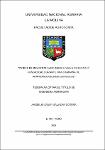Mostrar el registro sencillo del ítem
Perfil de resistencia de Botrytis cinerea a diferentes fungicidas durante una campaña de arándano (Vaccinium corymbosum)
| dc.contributor.advisor | Llanos Melo, Alejandro Kleper | |
| dc.contributor.author | Salazar Cotera, Jhoselin Sandy | |
| dc.date.accessioned | 2024-05-06T17:21:43Z | |
| dc.date.available | 2024-05-06T17:21:43Z | |
| dc.date.issued | 2024 | |
| dc.identifier.uri | https://hdl.handle.net/20.500.12996/6474 | |
| dc.description | Universidad Nacional Agraria La Molina. Facultad de Agronomía. Departamento Académico de Fitopatología | es_PE |
| dc.description.abstract | Botrytis cinerea es un hongo necrotrófico que afecta a diversos cultivos en todo el mundo. En nuestro país, el arándano forma parte de los productos de exportación más importantes. En la etapa de poscosecha este patógeno puede generar grandes pérdidas económicas mediante la pudrición del fruto. El uso de fungicidas para prevenir y manejar la enfermedad es la medida más utilizada e importante. Sin embargo, el desarrollo de la resistencia del patógeno a los fungicidas genera la pérdida de su eficacia. Para llevar a cabo el presente estudio, se colectaron 300 aislamientos en dos momentos distintos de la cosecha. Los aislamientos fueron provenientes de tres campos; dos bajo manejo convencional y un orgánico ubicados en la irrigación Chavimochic. Los aislamientos fueron evaluados con siete ingredientes activos y sus dosis discriminatorias respectivas. El crecimiento micelial fue evaluado con la finalidad de obtener el porcentaje de inhibición micelial (PIM) y la caracterización fenotípica del nivel de sensibilidad. De acuerdo a los resultados, en relación al PIM se observó que el azoxystrobin e iprodione presentaron el rango más amplio en los campos. Por el contrario, el fludioxonil presentó el valor más cercano a 100% de PIM. Así también con respecto al nivel de sensibilidad, los ingredientes que mostraron altos porcentajes de resistencia fueron azoxystrobin, cyprodinil y boscalid de 96.3%, 79.3% y 78.7%, respectivamente. Por otro lado, se registró un bajo porcentaje de resistencia al fludioxonil en los campos convencionales (1.5%). Finalmente, todos los aislamientos procedentes del campo orgánico fueron sensibles al fludioxonil, fenhexamid y pyrimethanil. El presente trabajo de investigación representa el primer estudio de resistencia en poblaciones de B. cinerea en el país, generando un gran soporte en la elaboración de estrategias de manejo para la enfermedad y prevención de resistencia a fungicidas. | es_PE |
| dc.description.abstract | Botrytis cinerea is a necrotrophic fungus that affects several crops worldwide. In our country, blueberries are among the most important export products. In the post-harvest stage this pathogen can cause significant economic losses through fruit rot. The use of fungicides to prevent and manage the disease is the most widely and important. However, the development of pathogen resistance to fungicides results in a loss of their effectiveness. For this study, 300 isolates of Botrytis were collected at two different times during the harvest. The isolates were obtained from three fields: two under conventional management and one organic, located in the Chavimochic irrigation. The monosporic isolates were evaluated with seven active ingredients and their respective discriminatory doses. Mycelial growth was assessed to obtain the percentage of mycelial inhibition (PMI) and the phenotypic characterization of sensitivity levels was conducted. According to the results, concerning PMI, azoxystrobin and iprodione showed the widest range in the fields. In contrast, fludioxonil presented the value closest to 100% PMI.In regarding sensitivity levels, ingredients with high resistance percentages were azoxystrobin, cyprodinil, and boscalid, with 96.3%, 79.3%, and 78.7%, respectively. On the other hand, a low resistance percentage to fludioxonil was recorded in conventional fields (1.5%). Finally, all isolates from the organic field were sensitive to fludioxonil, fenhexamid, and pyrimethanil. This research represents the first resistance study in B. cinerea populations in the country, providing significant support in the development of management strategies for the disease and the prevention of fungicide resistance. | es_PE |
| dc.format | application/pdf | es_PE |
| dc.language.iso | spa | es_PE |
| dc.publisher | Universidad Nacional Agraria La Molina | es_PE |
| dc.rights | info:eu-repo/semantics/openAccess | es_PE |
| dc.rights.uri | https://creativecommons.org/licenses/by-nc-nd/4.0/ | es_PE |
| dc.subject | Botrytis cinerea | es_PE |
| dc.title | Perfil de resistencia de Botrytis cinerea a diferentes fungicidas durante una campaña de arándano (Vaccinium corymbosum) | es_PE |
| dc.type | info:eu-repo/semantics/bachelorThesis | es_PE |
| thesis.degree.discipline | Agronomía | es_PE |
| thesis.degree.grantor | Universidad Nacional Agraria La Molina. Facultad de Agronomía | es_PE |
| thesis.degree.name | Ingeniero Agrónomo | es_PE |
| dc.subject.ocde | https://purl.org/pe-repo/ocde/ford#4.01.07 | es_PE |
| renati.author.dni | 75858106 | es_PE |
| dc.publisher.country | PE | es_PE |
| dc.type.version | info:eu-repo/semantics/publishedVersion | es_PE |
| renati.advisor.orcid | https://orcid.org/0000-0002-6032-4141 | es_PE |
| renati.advisor.dni | 44722455 | es_PE |
| renati.type | https://purl.org/pe-repo/renati/type#tesis | es_PE |
| renati.level | https://purl.org/pe-repo/renati/level#tituloProfesional | es_PE |
| renati.discipline | 811036 | es_PE |
| renati.juror | Espinoza Nuñez, Erick | |
| renati.juror | Apaza Tapia, Walter Eduardo | |
| renati.juror | Aragón Caballero, Liliana María |
Ficheros en el ítem
Este ítem aparece en la(s) siguiente(s) colección(ones)
-
AGR-FP Tesis [62]





